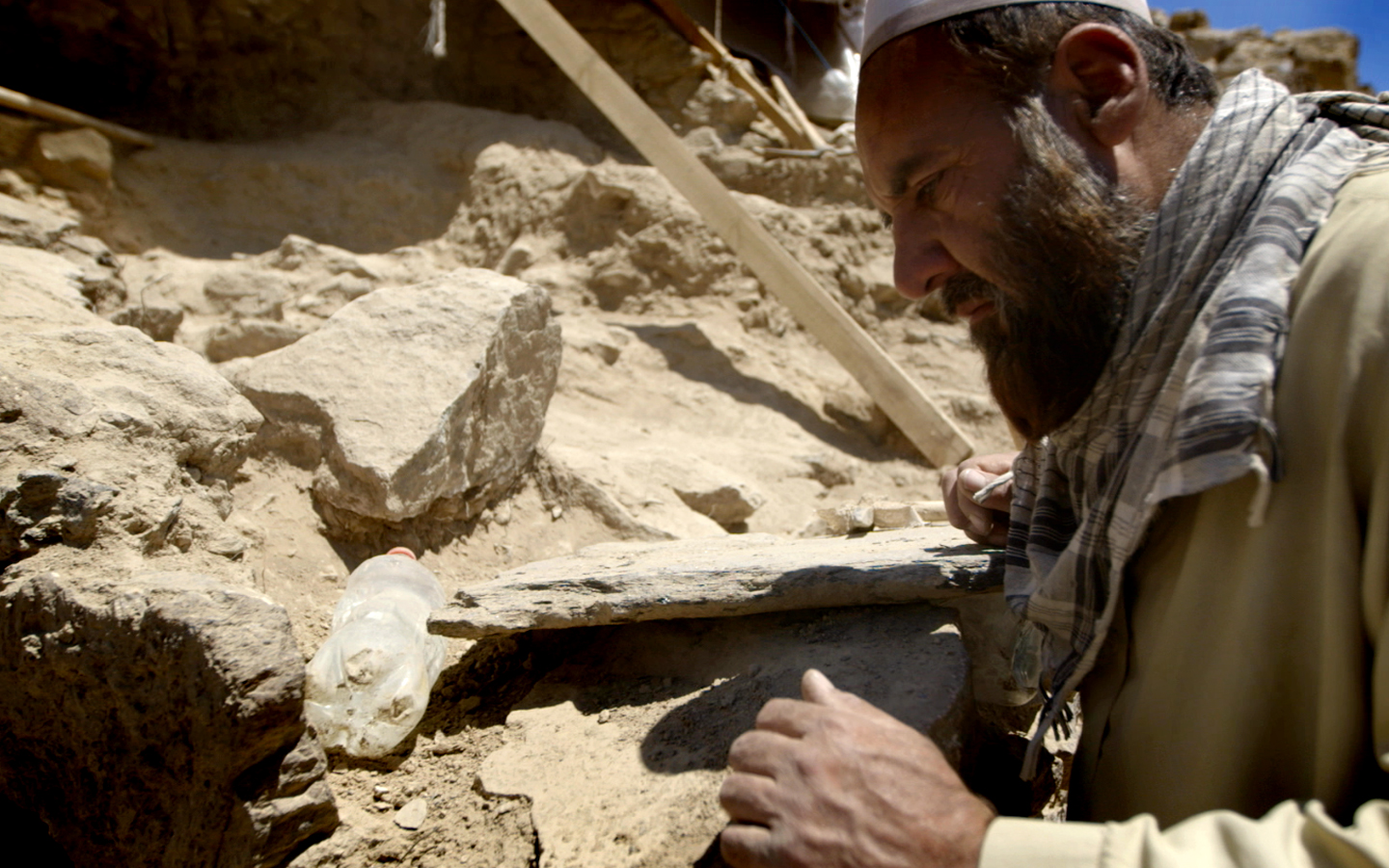The fortune of copper under an ancient Buddhist site in Afghanistan that China is supposed to mine
In 2008, the Afghan government and a state-owned Chinese company signed a deal to mine copper at Mes Aynak, just south of Kabul. The Taliban renewed the agreement. So why is the project stalled?

Between the fifth and seventh centuries AD, Mes Aynak was a major Buddhist settlement, about 25 miles southeast of modern-day Kabul, Afghanistan.
Its name is deceptive: Mes Aynak literally means “little source of copper” in the Afghan language of Pashto, but the area may have the world’s second-largest exploitable copper deposits.
In 2008, the China Metallurgical Group Corporation (MCC, 中国冶金科工集团有限公司) signed a 30-year lease for $3 billion to mine the copper. Afghanistan’s then minister of mines, Ibrahim Adel, said that the deal was the biggest investment in his country’s history, and that it would create about 10,000 jobs. Archaeologists rushed to document and preserve the temples and other structures at the site that the new mine would threaten.
However, more than 15 years after the deal was signed, mining is yet to commence.

Mes Aynak mine site, image from Google Earth.
Afghanistan seems a location well suited for Chinese mining, for other metals beyond copper: A 2010 study from the U.S. Defense Department found Afghan deposits of copper, rare earths, lithium, and various minerals could be worth more than $1 trillion, leading an internal departmental memo to declare the country the potential “Saudi Arabia of lithium.”
But MCC did not begin mining under the former U.S.-backed government of Hamid Karzai, and it continues to demur now, even though the Taliban government is keen for operations to begin.
“Wasn’t it you who was attacking us?”
It usually takes 10 or 20 years to get a mine operating, from the discovery of deposits to feasibility studies and then the construction of the mine. It’s a capital-intensive process. In Afghanistan, this is complicated by the lack of good roads and other basic infrastructure, including reliable energy and water supplies.
Nevertheless, the schedule in the initial contract (PDF on Afghan government site, archived here on The China Project), signed on May 25, 2008, between the Afghan government and MCC, gave an optimistic road map of five years for the mine to become operational.
MCC was supposed to pay $808 million in installments for the rights to the copper mineral deposits, and agreed to construct a railway, a coal-fired power station, a water supply and pipeline, and a smelter.
The contract states:
For the purposes of this Mining Contract, force majeure shall include wars, insurrections, civil disturbances, blockades, embargoes… epidemics…[and] acts of God or the public enemy.
This excerpt from the contract outlines several reasons beyond either party’s control for which the project could legitimately be put on hold. Security has been a long-running issue for the region until very recently. In May 2020, a group of Taliban insurgents stormed a security checkpoint near the site, killing eight security personnel and wounding five others.
An MCC official told the Associated Press that the road leading to the mine had been “laden with IEDs.” He said that he had joked with his Taliban hosts, on being told that they had restored safety so that work could resume, “Wasn’t it you who was attacking us?”
This was corroborated by a source working in the energy sector in Kabul, who spoke to The China Project on condition of anonymity. “Logar [the region in which Mes Aynak is located] was very insecure until the Taliban controlled the whole country…You literally could not drive south from Kabul, which is right next door. It was not a safe place.”
Does anyone care about historical treasures?
Javed Noorani, a freelance researcher and expert on Afghan mining industry in Kabul, told The China Project in an interview that “Aynak is blessed with two treasures: copper, and a historical heritage of unprecedented riches.”
This is because Mes Aynak is also the location of a former Buddhist metropolis, and is viewed as a major historical heritage site. Documentarian Brent E. Huffman, also interviewed for this story, released the film Saving Mes Aynak in 2014, garnering over 30 awards. Huffman spent four years in Afghanistan making the film. “There’s some of the oldest writing here, some of the oldest mural paintings, there’s thousands of years of Buddhist history,” he said.

One of the Mes Aynak archaeologists inspecting a newly discovered structure. Photo from the film Saving Mes Aynak.
Alongside the production of the film was a campaign to preserve the site, which helped raise funds for computers, digital cameras, and other vital equipment for the archaeological endeavor. A screening was even organized for then president Ashraf Ghani. Huffman also had access to MCC officials, whom he interviewed during the project.
“When I started filming, the Chinese company didn’t think the site mattered, historically or culturally.” However, as Noorani told The China Project, MCC “still uses the argument that heritage is the obstacle to the development of the site in order to delay.”
Huffman is pessimistic about the prospects for Mes Aynak’s protection, and notes that the plan now is still to destroy the site, after having moved some of the pieces. “Though I’ve been surprised,” he continues. “The Taliban isn’t destroying the site. They haven’t looted the museum…I think they’re playing nice because they want more deals with China. As far as I know, they’re pressing China as much as they can to start [mining] as soon as possible.”
China news, weekly.
Sign up for The China Project’s weekly newsletter, our free roundup of the most important China stories.
Another concern is environmental: Without the requisite caution, water sources, including an important aquifer and the Kabul River, could be contaminated for generations to come, causing what experts term a “Superfund site”: a failed site whose cleanup is so costly and so complicated that the mining company departs in disgrace while the national government is left to deal with the toxic disaster. And for a regime as cash-strapped as the Taliban, hopes would not be high for a swift cleanup.
Praying for money
As important as these causes for delay are, they seem of secondary concern to both the Taliban government, which is keen to start generating revenue from its hitherto barely tapped mineral wealth, and to MCC, which is, after all, a mining company.
However, it appears that the Chinese side is reluctant to reengage for the time being. Mentions of Mes Aynak on MCC’s website in the last five years are fleeting, and do not commit to restarting the mine. At best, two reports from August and October 2021 talk of “striving to start the copper mine project as soon as possible,” and “praying for the smooth restart of the Aynak project.”

Mes Aynak mine: Photo by anonymous via Syed Fazl-e-Haider.
Speak to anyone in the mining industry, and they will tell you that thoughts and prayers have little currency. But according to an anonymous industry source in Kabul, one currency that the Chinese side has relied on over the years is bribery.
“As the Chinese mining giant signed the contract, a lot of money was exchanged. The first vice president of Afghanistan, Ahmadzai Masood, was accused of having gotten a couple of million dollars,” they told The China Project. Other estimates have put that sum as high as $30 million.
Noorani also says that for a while, MCC “would pay $2,000 per month to the head of the Aynak authorities to keep quiet on Chinese obligations and the timeline for development of the site.”
The Chinese businesspeople at Mes Aynak
The original signatory for MCC, former group chairman Shěn Hètíng 沈鹤庭, was kicked out of the Communist Party on corruption charges in 2017, though it is unknown whether that related to his involvement with the Mes Aynak project.
Beyond this headline project, there have been a number of Chinese businesspeople who have tried to capitalize on the opportunities that Afghanistan’s mineral deposits present.
One source in Kabul told The China Project that these actors typically don’t have government approval. Most of them don’t come from China’s coastal provinces, they’re not often well educated, they’re people who don’t have any opportunities in China. One such person they were aware of had to leave China because he had killed his wife.
In a documentary that aired on Al Jazeera in November 2022 called “The Chinese entrepreneurs chasing an Afghan ‘gold rush,’” which follows the failed ventures of three Chinese businessmen, one is in the mining industry. He complains toward the end that there is no certainty from the Afghan government, arguing that the minister responsible for mines had changed several times since August 2021, and it has been possible for people to buy land with government permission, only for that later to be taken away: It’s like a “a cake on top of a mousetrap” (鼠夹上的蛋糕), the man lamented.
This uncertainty undoubtedly lies behind the reticence of MCC and other potential Chinese state-directed investments.
While a position paper published in April by the Chinese government stated its support for Afghanistan’s integration into regional economic cooperation and connectivity, it’s not for nothing that Beijing is yet to officially recognize the Taliban government. Beyond Mes Aynak and an oil field project signed in 2011 by the China National Petroleum Corporation and its Afghan joint-venture partner, Watan, no other deals have been signed.
While China has much better options for mineral extraction in Latin America and Africa, and is sitting on a 30-year lease at Mes Aynak, there is no need for it to mete out more than pablum to the Afghan government.

Mes Aynak mine: Photo by anonymous via Syed Fazl-e-Haider.
The electric car connection
There is one further level to the Mes Aynak story that is yet to be uncovered. According to a U.S. Geological Survey report from 2011, one mineral besides copper that is present at the Aynak site is cobalt.
Per the report: “An estimate of the contained cobalt resource is not available due to insufficient assays; however, cobalt content of ores ranging from 0.015 to 0.3 percent have been reported and may represent significant added value.”
Cobalt is primarily used in lithium-ion batteries, the principal type of battery used in electrical vehicles, and thus is of critical value to the energy transition, and to a sector that China is widely seen to be dominating.
The report concludes that “the future potential for discovery of additional copper-cobalt deposits in the Aynak area of interest and subareas is regarded as high.” A report from the Brookings think tank published in August last year, which focuses on the mining of lithium — the second in the trifecta of battery elements, along with nickel, that will power the green industrial revolution — argues that Beijing’s most likely strategy is “to retain an option for large-scale development down the line while waiting to see how Afghanistan’s politics and commercial lithium markets shake out.”
The original Mes Aynak contract stipulates that MCC would have to request additional rights to develop mineral deposits beyond copper. While we do know that renegotiations with the Taliban have been ongoing, the substance of those negotiations are as yet unknown. But it is feasible that the prospect of exploiting battery minerals adds a further dimension to what is already a situation of significant complexity.
For now, China and MCC hold all the cards. Ultimately, what will happen will depend much more on Beijing’s geopolitical calculus than on the preferences of the Taliban. Meanwhile, as Noorani noted in our interview, “Afghanistan is the loser, and receives neither revenue nor employment.”






